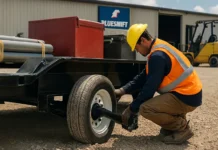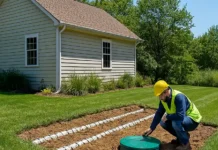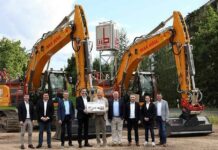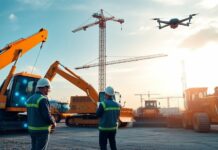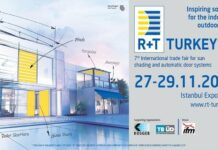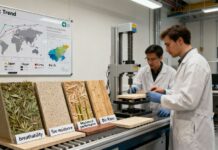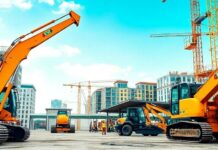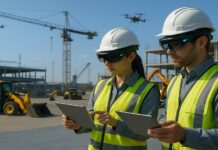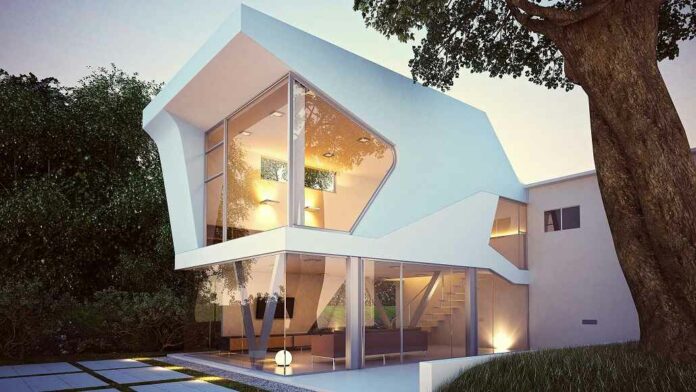Smart Molds: AI and Machine Learning in the Digital Fabrication of Composite Architecture
Digital fabrication has quickly gone from being a niche area of technology to an important part of modern design in the past decade. Within this domain, one of the most promising developments is the integration of smart molds—digital, data-driven systems empowered by artificial intelligence (AI) and machine learning (ML)—in the fabrication of composite architectural elements. Not only are these technologies changing the way things look and work, but they are also changing how sustainable, efficient, and flexible modern design is
The Rise of Composite Architecture in the Digital Age
Fiber-reinforced polymers (FRPs), carbon fibre, and other synthetic or hybrid composites are just some of the materials that are used in composite construction. Compared to common building materials like steel or concrete, these materials are stronger for their weight, don’t rust, and can be shaped easily. They are, however, difficult to make in their own way, especially during the shaping and curing steps.
Digital manufacturing is accurate, can be programmed, and can be scaled up or down. With methods like robotic filament winding, CNC-based fibre placement, and additive manufacturing, it is now possible to make custom composite shapes that are physically better. A new breed of smart moulds is at the heart of this new era of digital fabrication.
What Are Smart Molds?
Smart moulds are mould systems that are adaptable and have sensors built in. They use AI and machine learning to react to changes in the manufacturing process in real time. Smart moulds can change form, temperature, pressure, and even vibration during the manufacturing process to get the best results from the materials. This is different from static moulds, which are fixed and can’t move.
Smart moulds give us more control over the flow of resin, the arrangement of fibres, and the speed at which the composite hardens than ever before. These moulds can react dynamically to get the best conditions for making high-performance composite structures by combining real-time data with predictive algorithms.
Core Technologies Behind Smart Molds
- Embedded Sensors: These are sophisticated electronics built into the mould that constantly monitor internal and surface conditions. For example, thermocouples monitor temperature variations to prevent hotspots during curing, whereas fibre optic sensors sense strain and maintain consistent fibre tension. Pressure transducers assess internal pressures to avoid delamination or voids in the composite structure, while dielectric sensors monitor the resin’s electrical characteristics to forecast cure states.
- Actuation Systems: Unlike traditional molds that remain rigid throughout the process, smart molds incorporate actuation systems such as pneumatic actuators, shape memory alloys (SMAs), and piezoelectric elements. These systems allow real-time adjustments in the mold’s geometry or surface characteristics, helping accommodate design changes or correct inconsistencies during manufacturing.
- AI/ML Algorithms: Sensor data is processed with powerful AI and machine learning techniques. These algorithms are taught using massive databases on material behaviours and past manufacturing outcomes. Supervised learning approaches allow the system to improve its forecast accuracy over time, resulting in better decision-making with each use. For example, the system can identify an impending flaw and adjust temperature or pressure to preemptively repair the problem.
- Digital Twins: These are virtual representations of the mould and fabrication process created from real-world data and simulations. Digital twins can be used to evaluate alternative fabrication parameters before proceeding to physical production, hence reducing risk. They also enable iterative improvements by simulating stress distribution, heat profiles, and resin flow dynamics.
| Technology | Function | Role in Smart Mold Ecosystem |
| Embedded Sensors | Real-time data capture | Enables process transparency |
| Actuation Systems | Dynamic response | Adjusts form or environment |
| AI/ML Models | Predictive analysis | Optimizes fabrication outcomes |
| Digital Twins | Simulation & validation | Minimizes trial-and-error |
Applications in Contemporary Architecture
AI-enhanced smart moulds are rapidly being employed in both experimental and commercial applications. One significant example is the development of curved FRP panels for façade systems. In these circumstances, typical moulds would necessitate expensive, single-use tooling. Smart moulds, on the other hand, allow for changeable surfaces that adapt to diverse geometries on demand, significantly lowering costs while improving design freedom.
In a recent case study by a German research collaboration, smart moulds were used to create intricate composite arches for a lightweight pavilion. Using artificial intelligence to track curing temperature and fibre tension, the system performed mid-process changes, resulting in a 32% reduction in material waste and a 15% improvement in mechanical performance over conventionally moulded counterparts.
Another growing application is kinetic architecture, which refers to buildings that alter shape in reaction to environmental stimuli. This transition can be enabled by smart composite elements made with AI-driven moulds, which combine structural integrity and adaptable capabilities. These improvements are resulting in a new class of ‘living’ buildings that can dynamically adjust to climate, light, and human presence.
Advantages Over Traditional Mold Systems
Smart moulds give composite architecture a number of revolutionary benefits. Because of their versatility, they can create several geometries from a single mould, doing away with the need for separate tools for every component. Real-time sensor feedback greatly improves precision, leading to components of greater quality and fewer flaws.
Another significant advantage is sustainability. Smart moulds minimise resin use and energy consumption by optimising curing cycles and material distribution. This reduces carbon emissions and supports international green construction objectives. Because reusable mould platforms and less waste result in lower overall costs, cost efficiency is also increased.
Chart: Comparative Metrics — Traditional vs. Smart Molds
| Metric | Traditional Mold | Smart Mold |
| Setup Cost | High (custom for each shape) | Moderate (reusable platform) |
| Material Waste | High | Low (optimized usage) |
| Fabrication Time | Fixed per geometry | Adaptive and reduced |
| Design Flexibility | Low | High |
| Environmental Impact | High | Reduced through optimization |
Market Outlook and Future Projections (2024–2032)
The global market for digital fabrication in architecture that is incorporated with AI is on the brink of significant growth. As per the 2024 Global Smart Manufacturing Report, the composite construction segment that incorporates AI is anticipated to expand at a compound annual growth rate (CAGR) that surpasses 11% by 2032.
This development is primarily driven by the growing demand for sustainable and lightweight construction solutions, particularly in the fields of modular architecture, aerospace-inspired buildings, and urban infrastructure. The industry is also being compelled to adopt intelligent, data-driven fabrication methods in response to government regulations that encourage the adoption of green construction practices.
Key Drivers of Market Adoption
A combination of societal, environmental, and technological concerns is driving the adoption of smart moulds:
- Urban Density: The requirement for vertical growth and space-efficient construction technologies is increasing as urban populations rise. Smart moulds are used to create lightweight composite constructions that minimise dead loads and enable more intricate geometries in constrained spaces.
- Sustainability Regulations: Energy-efficient construction methods are becoming more and more in demand as governments throughout the world enforce higher emissions and energy standards. Smart moulds fit in nicely with these regulatory objectives because they minimise waste and maximise energy consumption.
- Customization Demand: Bespoke and hyper-local designs that take into account environmental context and cultural narratives are currently in vogue in architecture. Delivering such unique components in a scalable and economical manner without sacrificing structural performance is made possible by smart moulds.
Difficulties and Technical Restrictions
Smart moulds have drawbacks despite their potential. Complexity of integration is still a big obstacle, particularly for interdisciplinary teams (material scientists, architects, and AI engineers). Successful implementation depends on ensuring efficient knowledge transfer and communication across areas.
Another issue is sensor dependability. Outcomes that are less than ideal or even defective can result from inaccurate or delayed data. For smaller businesses, the initial expense of high-precision sensors and actuators may also be unaffordable. Additionally, interoperability and scalability are made more difficult by the lack of standardised AI protocols designed specifically for architectural construction.
Modular technology stacks, industry partnerships, and open-source development frameworks may be able to lessen these restrictions and promote wider use.
The Path Ahead
We may expect smart moulds to be used more widely in prefabrication facilities and on active construction sites by 2032. On-site adaptive fabrication might soon be a reality thanks to developments in portable robotics and Internet of Things-enabled technologies.
The next stage of development is probably going to be led by hybrid systems that combine mobile 3D printers, robotic arms, and AI-guided moulds. These systems are capable of producing complete building modules on demand, providing answers for pressing infrastructure requirements such as pop-up buildings in cities, rural clinics, and housing for disaster relief.
You should anticipate greater interaction between design software, simulation platforms, and fabrication gear as the industry continues to digitise. Architects will be able to test, simulate, and create their ideas with previously unheard-of speed and accuracy because to this convergence.
In conclusion
More than just a technological advancement, smart moulds are changing the way we think about, plan, and build our built environment. Artificial intelligence and sensor-rich fabrication systems have been combined to give engineers and architects tools that actively learn, adapt, and improve their output in real time rather than merely following instructions.
A new era where efficiency, customisation, and sustainability are not mutually exclusive but rather coexisting values is being ushered in by this transformative power. Smart moulds present an appealing solution based on science and driven by innovation in a field where architecture must adapt to important issues like resource scarcity, urbanisation, and climate change.
As we approach the next frontier, it is evident that smart moulds are influencing the direction of architectural intelligence itself rather than just making better building possible.



